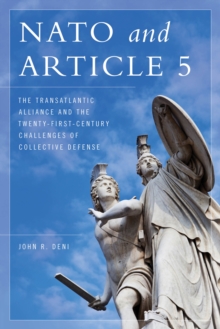Description
| Product ID: | 9781538107027 |
| Product Form: | Hardback |
| Country of Manufacture: | US |
| Title: | NATO and Article 5 |
| Subtitle: | The Transatlantic Alliance and the Twenty-First-Century Challenges of Collective Defense |
| Authors: | Author: John R. Deni |
| Page Count: | 180 |
| Subjects: | Warfare and defence, Warfare & defence |
| Description: | Select Guide Rating Is NATO prepared to return to collective defense in the face of Russia’s annexation of Crimea, invasion of Ukraine, and aggressive posturing across northeastern Europe? Arguing that NATO faces critical hurdles in re-embracing collective defense, this text offers practical solutions aimed at adjusting alliance strategy, resourcing, and readiness. For much of the last 25 years, NATO has focused on crisis management in places such as Kosovo and Afghanistan, resulting in major changes to alliance strategy, resourcing, force structure, and training. Re-embracing collective defense —which lies at the heart of the Treaty of Washington’s Article 5 commitment— is no easy feat, and not something NATO can do through rhetoric and official pronouncements. Nonetheless, this shift is vitally necessary if the alliance is to remain the bulwark of Western defense and security. Russia’s illegal annexation of Crimea and its invasion of Ukraine have fundamentally upended the security environment in Europe, thrusting NATO into the spotlight as the primary collective defense tool most European states rely upon to ensure their security. Collective defense is one of the alliance’s three core missions, along with crisis management and cooperative security. It is defined in Article 5, the most well-known and arguably most important part of NATO’s founding treaty, which states: “The Parties agree that an armed attack against one or more of them in Europe or North America shall be considered an attack against them all.” Although all three missions are vital to the interests of NATO’s many member states, collective defense has become first among equals once again. However, three very significant hurdles stand in the way of the alliance and its member states as they attempt to re-embrace collective defense. These loosely correspond to an ends-waysmeans construct. First is the alliance''s strategy toward Russia. Is Russia an adversary, a partner, neither, or both? How should strategy and policies change to place the alliance and its members on more solid ground when it comes to managing Russia? Second are the ongoing disputes over resourcing and burden-sharing. In recent years, it has become commonplace for American leaders to publicly berate European allies in an effort to garner more contributions to the common defense. How might the alliance better measure and more equitably share security burdens? Third is the alliance’s readiness to fulfill its objectives. Many allies have announced or are implementing increases in defense spending. However, governments of European NATO member states are strongly incentivized by domestic politics to favor acquisition of military hardware or spending on personnel salaries and benefits, usually at the expense of readiness. The result is that NATO military forces risk quickly becoming hollow in a way that is often underappreciated, which will prevent the alliance from fulfilling the collective defense promise inherent in Article 5. The book examines all such questions to assess NATO’s return to collective defense and offer a roadmap for overcoming those challenges in both the short and long-term. |
| Imprint Name: | Rowman & Littlefield |
| Publisher Name: | Rowman & Littlefield |
| Country of Publication: | GB |
| Publishing Date: | 2017-10-04 |


